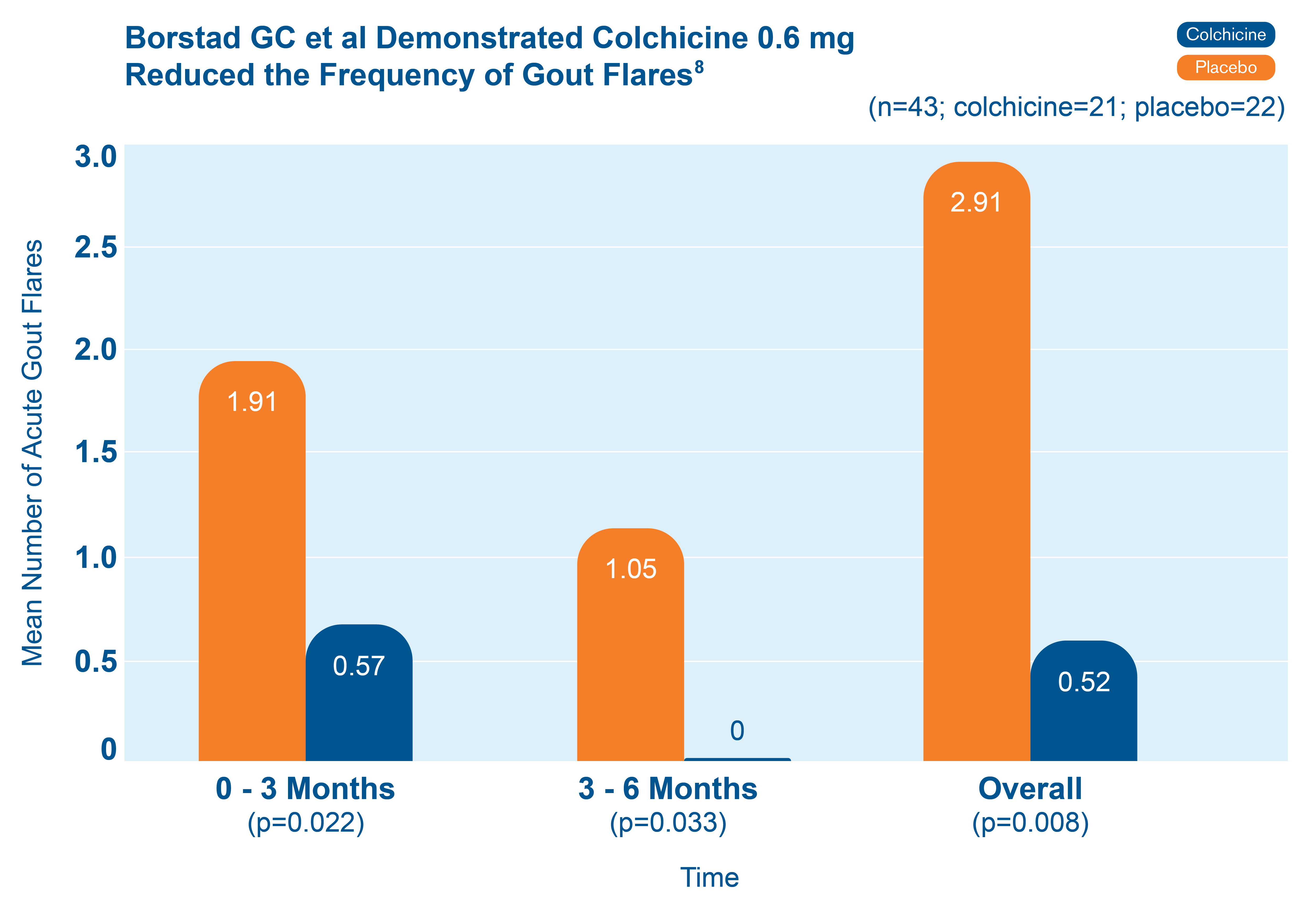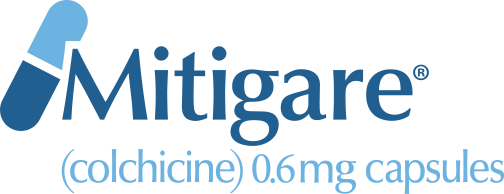
More than 8 million Americans suffer with gout.1 But many don’t know they have gout because they haven’t experienced gout flares. It’s important to understand the difference between gout and gout flares.
Gout, a form of inflammatory arthritis, has been around since ancient times.2 The painful swelling and redness of gout flares often begins in the big toe.3 However, gout flares can occur in other body parts as well, such as the feet, ankles, knees, elbows, wrists and fingers.3
What causes gout?
The root cause of gout is excess uric acid in the bloodstream.3 This excess uric acid can build up in tissues and form sharp, needle-like urate crystals in the joints that cause inflammation and pain.3 The body makes uric acid when it metabolizes purines.3 Purines are chemicals found in many foods.3 They also occur naturally in our bodies.3
What does it mean to have gout?
Just because a person has gout does not necessarily mean that they will suffer with gout flares.4 Gout begins gradually, and for some people there are no symptoms at first.4 The four stages of gout are:
Asymptomatic hyperuricemia
Although no gout symptoms are present, the uric acid level in the bloodstream is higher than normal.4 Medication is not usually necessary at this point, but the doctor may recommend diet and/or lifestyle changes to reduce the risk of flares.4
Acute gout
At this point, the uric acid crystals that have been accumulating in a joint can suddenly cause intense pain and swelling.4 Fever may also be present.4 The pain of a gout flare might be severe enough to warrant an emergency room visit. Although another flare may not happen for months or even years, the patient should visit the doctor for a formal evaluation and consideration of medication to help prevent flares.4
Intercritical gout
Although no symptoms may be present between gout flares, uric acid crystals continue to accumulate in the joints.4 If high uric acid levels are untreated, it is likely that the patient will continue to have painful gout flares.4
Chronic tophaceous gout
At this stage, uric acid crystals harden into tophi—chalky whitish lumps that form under the skin.5 The disease has progressed to a form of chronic arthritis, where bone and cartilage have become deformed and may eventually be destroyed.4 Due to the ongoing, inflammatory nature of the disease, kidney damage is also possible.5
What happens during a gout flare?
When the uric acid level in the body reaches a certain level, a person could experience a gout flare.3 During a gout flare, a joint may suddenly feel excruciatingly painful and is tender, red and swollen.3 This pain can linger for a few days or as long as a few weeks.3
Can gout flares be prevented?
Yes. is one of the most frequently used medicines for preventing the inflammation associated with gout flares.6 Originally derived from a plant called the autumn crocus (Colchicum autumnale), colchicine has been used to prevent gout flares in adults.2
Certain lifestyle modifications may also help reduce your risk of gout flares.7 These include drinking plenty of water, limiting or avoiding alcohol, limiting your intake of meat and certain kinds of fish and maintaining a healthy weight.7
Is colchicine effective?
Clinical research shows that colchicine helps prevent gout flares in adults with gout.8 One study showed that adults who took colchicine 0.6 mg daily had fewer gout flares than those who did not.8 They also had fewer gout flares as time went on.8
Fewer total flares with colchicine 0.6 mg than with placebo8

43 patients starting allopurinol were randomized to receive colchicine 0.6 mg or placebo for up to 6 months. The chart shows the mean number of acute gout flares at the 0-3 and 3-6 month time periods, and overall.8
Is colchicine safe?
In a six-month study of daily use in patients with recurrent gout, colchicine 0.6 mg was shown to be well tolerated.8 The most commonly reported adverse reactions with colchicine are gastrointestinal symptoms, including diarrhea, nausea, vomiting and abdominal pain.9 If your doctor prescribes colchicine, make sure he or she knows about any other medications you are currently taking.
Colchicine 0.6 mg capsules are contraindicated in patients with renal or hepatic impairment who are currently prescribed drugs that inhibit both P-gp and CYP3A4. Combining these dual inhibitors with colchicine in patients with renal or hepatic impairment has resulted in life-threatening or fatal colchicine toxicity. Patients with both renal and hepatic impairment should not be given colchicine.
Fatal overdoses have been reported with colchicine in adults and children. Keep colchicine out of the reach of children.
Blood dyscrasias such as myelosuppression, leukopenia, granulocytopenia, thrombocytopenia and aplastic anemia have been reported in patients taking colchicine at therapeutic doses.
Monitor for toxicity and if present consider temporary interruption or discontinuation of colchicine.
Could I have gout?
If you think you may have gout, talk with your doctor. You may want to download and complete the Gout Flare Questionnaire (from resources for patients) before your appointment. He or she may be able to recommend lifestyle changes and/or prescribe medicine that can help you prevent gout flares.
NOTE: This article was not written by a medical professional and is not intended to substitute for the guidance of a physician. These are not West-Ward’s recommendations for gout flare prevention, but rather facts and data collected from various reliable medical sources. For a full list of resources and their attributing links, see below.
